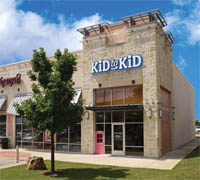Resale Retail: Printing In The Self-Contained Supply Chain

By Matt Pillar, chief editor
January 2014 Integrated Solutions For Retailers
At hip resale retailer Kid to Kid, the POS workstation serves receiving, tagging, labeling, and transaction duties, requiring a unique printing environment.
Listen up, inventory managers. If you think supply chain and merchandising challenges make your job tricky, try getting a grip on the inventory insanity in the children’s clothing resale business.
 There is no forecast. There is no shipment schedule. There are no warehouses or DCs. Heck, on any given day, there’s no guarantee you’ll receive any merchandise at all, and on another given day, you might receive more than you know what to do with. Inventory receipt is entirely dependent on when the moms in your neighborhood decide it’s time to clean out their kids’ closets.
There is no forecast. There is no shipment schedule. There are no warehouses or DCs. Heck, on any given day, there’s no guarantee you’ll receive any merchandise at all, and on another given day, you might receive more than you know what to do with. Inventory receipt is entirely dependent on when the moms in your neighborhood decide it’s time to clean out their kids’ closets.
How do you plan for that? And still, you have to buy and merchandise in season. You have to turn stock and keep it fresh, you have to mark down, and you have to measure and report on sales. Short of manufacturing, it’s like running the entire supply chain — blindfolded — from behind the counter of your stores.
Those concerns didn’t get in the way of Shauna and Brent Sloan, who opened their first resale store in 1992 and, in the 21 years since, have grown their business to 112 Kid to Kid and Uptown Cheapskate stores worldwide.
A Demanding Environment For Printers
Brent Cox, IT support representative for the franchise operation, says label and hangtag printing is tantamount to doing business in the business he’s in. “We have to tag a garment with a bar code in order to sell it, and we have to do it quickly,” he says.
Speed is of the essence in the retailer’s model, because everything from analysis and receipt of goods to preparation of goods for resale is handled at the front of the store. Received items are entered into a custom buying program at the point of service/point of sale, creating an item file and prompting one of each store’s three to six Cognitive DLX and DLXi printers to crank out a serialized bar code. “The tags and labels feature our logo and a bar code that must render clean, crisp, and readable every time,” says Cox.
The Cognitive DLX units were a 2009 upgrade from the vendor’s earlier Advantage LX model — an upgrade that garnered Kid to Kid USB connectivity and a 50 percent improvement in print speed. “Speed is important because a single environment serves both retail and production functions. Printing speed improves our productivity and customer service.” Of course, the integration of the printers didn’t go without a hitch. It sounds simple enough, but Microsoft didn’t necessarily make printer management plans for retailers who plug two or more USB-powered printers into the same computer. “We had to put some timing into the program to adjust the print buffer; otherwise our print spools would stop under certain circumstances,” says Cox. “Understandably, Microsoft’s priority is not specialty printing.”
Brent Cox, IT support representative, Kid to Kid
 The DLXi units at Kid to Kid are being phased in as the retailer’s DLX equipment reaches end of life, though Cox says that’s slow to happen. “We like the DLXi because it features an adjustable form setting, which allows us to adjust our label layout if necessary,” he says, “but we’re not replacing the DLX units unless we have to, and many of them continue to perform well for us after 10 years of service.”
The DLXi units at Kid to Kid are being phased in as the retailer’s DLX equipment reaches end of life, though Cox says that’s slow to happen. “We like the DLXi because it features an adjustable form setting, which allows us to adjust our label layout if necessary,” he says, “but we’re not replacing the DLX units unless we have to, and many of them continue to perform well for us after 10 years of service.”
Despite their printers’ reliability, Cox says even the smallest two-workstation Kid to Kid stores deploy a minimum of three bar code label printers. Sometimes, they’re all humming at once. When they are, they create peace of mind. “In IT, one is a horrible number,” he says. “One breaks down to zero. If we’re not printing bar codes, we’re not making money.”
For More Information On Cognitive TPG Go To www.cognitivetpg.com
